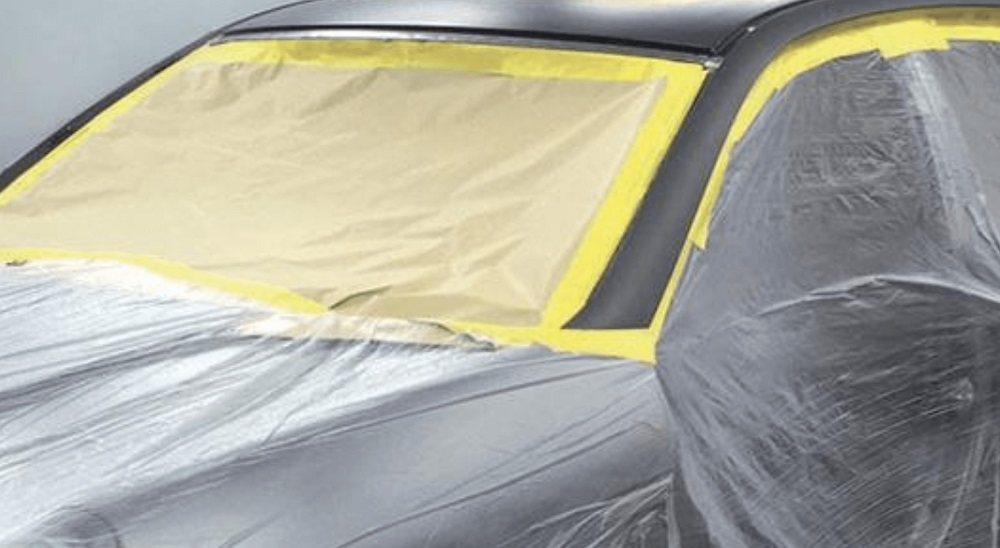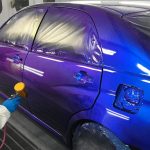In the world of automotive enthusiasts and do-it-yourself (DIY) aficionados, the use of painters tape has become as common as a trusty wrench. However, a lingering question persists in the minds of many: “Will painters tape damage car paint?” This comprehensive guide seeks to unravel the intricacies of employing painters tape on your cherished vehicle, exploring potential risks, and providing expert advice on preserving your car’s flawless finish.
Table of Contents
- Understanding the Concerns: Will Painters Tape Cause Harm?
- The Science Behind Painters Tape Composition
- Common Misconceptions About Painters Tape
- Best Practices for Using Painters Tape on Your Car
- Real-Life Experiences: Success Stories and Cautionary Tales
- Expert Recommendations and Insights
- Expert Tips for Safeguarding Your Car’s Paint with Painters Tape
- 1. Choose High-Quality Painters Tape
- 2. Test on a Small, Inconspicuous Area First
- 3. Prioritize Surface Preparation
- 4. Use the Right Application Technique
- 5. Remove Tape at the Right Time
- 6. Be Mindful of Temperature Conditions
- 7. Mask Off Delicate Areas Carefully
- 8. Invest in Precision Detailing Tape
- 9. Check for Compatibility with Paint Types
- 10. Seek Guidance from Automotive Professionals
- FAQs: Navigating the Tapestry of Painters Tape and Car Paint
- 1. Does Painters Tape Damage Car Paint?
- 2. How Do I Choose the Right Painters Tape for My Car?
- 3. Can I Leave Painters Tape on for an Extended Period?
- 4. Is Painters Tape Safe for All Types of Car Paint?
- 5. How Do I Prevent Adhesive Residue on My Car?
- 6. Can I Use Painters Tape on Detailed or Curved Areas of My Car?
- 7. What’s the Difference Between Regular Painters Tape and Detailing Tape?
- 8. Can I Apply Painters Tape in Extreme Temperatures?
- 9. Should I Test Painters Tape on My Car Before a Project?
- 10. How Do Professionals Achieve Clean Lines with Painters Tape?
- Conclusion: Striking the Perfect Balance
Understanding the Concerns: Will Painters Tape Cause Harm?
Dispelling Myths About Painters Tape
Before we embark on our exploration, let’s debunk some myths. There’s a prevalent belief that any tape can be used for automotive projects, leading to the misconception that painters tape is a one-size-fits-all solution. However, understanding the science behind painters tape is crucial to dispelling such myths.
The Science Behind Painters Tape Composition
Painters tape is specifically designed for delicate surfaces, often using a combination of low-tack adhesives and thin, flexible backing material. This composition aims to provide a secure hold without causing damage. Exploring the intricate details of painters tape’s construction will shed light on why it’s a preferred choice for many DIY automotive projects.
Adhesive Properties: Friend or Foe?
One of the primary concerns is the adhesive’s impact on car paint. We’ll delve into the nitty-gritty of adhesive chemistry, discussing why some tapes leave residue while others do not. Understanding these properties is crucial for selecting the right tape for your specific needs.
Common Misconceptions About Painters Tape
All Tapes Are Not Created Equal
Not all painters tapes are created equal. There are variations in adhesive strength, backing material, and overall quality. We’ll explore the market’s offerings, emphasizing the importance of choosing a painters tape suitable for automotive applications.
Tape Removal Mythology
Another common misconception revolves around the removal process. Some believe that leaving tape on for extended periods is harmless, while others fear that removing it too quickly may damage the paint. Let’s demystify these notions and outline the best practices for tape removal.
Best Practices for Using Painters Tape on Your Car
Now that we’ve addressed concerns and debunked myths, let’s delve into actionable advice. Discover the best practices for using painters tape during various automotive projects, ensuring you not only protect your car’s paint but also achieve professional-looking results.
1. Choosing the Right Type of Painters Tape
Selecting the appropriate tape is paramount. We’ll provide an in-depth analysis of the features to look for when choosing painters tape, ensuring it meets the demands of automotive applications.
2. Proper Surface Preparation
Prevention is better than cure. Learn the significance of adequately preparing your car’s surface before applying painters tape. Our step-by-step guide will walk you through the pre-taping process, promoting optimal adhesion and preventing potential damage.
3. Correct Application Techniques
It’s not just about sticking tape on the surface. Discover the right techniques for applying painters tape to achieve clean lines without risking damage. We’ll share professional tips for flawless execution, covering everything from masking curves to intricate details.
4. Duration of Tape Application
How long is too long when it comes to leaving painters tape on your car? We’ll provide detailed guidelines on the ideal duration for various projects, ensuring you avoid any potential adhesive residue or paint damage. (See Also: Can You Wax Chrome Exhaust? Tips for Polishing and Protecting Your Vehicle’s Shine)
Real-Life Experiences: Success Stories and Cautionary Tales
Triumphs and Challenges
In this section, we’ll feature anecdotes from fellow car enthusiasts who’ve successfully used painters tape and those who’ve faced challenges. Learning from real-life experiences adds a practical dimension to our guide, offering valuable insights and tips.
Expert Recommendations and Insights
Professional Perspectives
Seeking advice from industry experts, we’ll compile insights on using painters tape for different purposes. From professional painters to detailing specialists, discover their tips for preserving your car’s paint. These expert perspectives provide a wealth of knowledge for both beginners and seasoned DIYers.
Expert Tips for Safeguarding Your Car’s Paint with Painters Tape
When it comes to using painters tape on your car, a bit of expert advice can go a long way in ensuring a flawless finish. Let’s dive into some invaluable tips from seasoned professionals in the automotive world.
1. Choose High-Quality Painters Tape
Invest in painters tape specifically designed for automotive use. High-quality tapes have the right balance of adhesive strength and gentle backing material, minimizing the risk of paint damage.
2. Test on a Small, Inconspicuous Area First
Before applying painters tape to prominent areas of your car, conduct a small-scale test on an inconspicuous spot. This allows you to assess how the tape interacts with your car’s paint without risking damage to a visible area.
3. Prioritize Surface Preparation
A clean surface is paramount for successful tape adhesion. Thoroughly clean and dry the areas you plan to tape, removing any dirt, wax, or contaminants that could compromise the tape’s effectiveness.
4. Use the Right Application Technique
Apply painters tape with care, ensuring it adheres evenly without gaps or bubbles. Press down on the tape gently but firmly, and consider using a plastic squeegee to smooth the edges for a tight seal.
5. Remove Tape at the Right Time
Don’t leave painters tape on for longer than necessary. Remove it promptly after completing your project to avoid adhesive residue and potential paint damage. Refer to the tape manufacturer’s recommendations for the ideal removal time.
6. Be Mindful of Temperature Conditions
Extreme temperatures can impact tape performance. Avoid applying painters tape in excessively hot or cold conditions, as this can affect adhesive properties. Aim for moderate temperatures for optimal results.
7. Mask Off Delicate Areas Carefully
When working around delicate areas like emblems or trim, take extra care. Use precision cutting techniques or smaller strips of tape to mask off these details, ensuring a clean and professional result.
8. Invest in Precision Detailing Tape
For intricate projects, consider using precision detailing tape in addition to regular painters tape. Detailing tape allows for more precise lines and is particularly useful for intricate designs and curves. (See Also: Scotchgard Auto vs Scotchgard Fabric: Choosing the Best Protection for Your Car Interior)
9. Check for Compatibility with Paint Types
Different paints may react differently to tape. Check the compatibility of the tape with the type of paint on your car. This is especially important if you have a custom or specialty paint job.
10. Seek Guidance from Automotive Professionals
If you’re uncertain about a particular project or tape choice, don’t hesitate to consult with automotive professionals. They can provide tailored advice based on your specific needs and help you achieve professional results.
By incorporating these expert tips into your automotive projects, you’ll not only protect your car’s paint but also elevate the quality of your work. Happy taping!
As you venture into the world of using painters tape on your car, it’s natural to have questions. Let’s unravel the most frequently asked questions and provide clear, concise answers to guide you through the intricacies of this automotive essential.
1. Does Painters Tape Damage Car Paint?
Answer: When used correctly, painters tape is designed to be gentle on car paint. Choosing high-quality tape, proper application, and timely removal significantly reduce the risk of damage.
2. How Do I Choose the Right Painters Tape for My Car?
Answer: Opt for painters tape explicitly designed for automotive applications. Look for tapes with low-tack adhesives and a delicate backing to ensure a secure hold without harming the paint.
3. Can I Leave Painters Tape on for an Extended Period?
Answer: While painters tape is temporary, leaving it on for too long can result in adhesive residue. Remove the tape promptly after completing your project, following the manufacturer’s recommended removal time.
4. Is Painters Tape Safe for All Types of Car Paint?
Answer: In general, painters tape is safe for most car paints. However, it’s essential to check for compatibility, especially if you have a custom or specialty paint job. Conduct a small test in an inconspicuous area if you’re uncertain.
5. How Do I Prevent Adhesive Residue on My Car?
Answer: Proper surface preparation is key. Ensure the surfaces are clean, dry, and free from contaminants before applying painters tape. Removing the tape at the right time also minimizes the risk of residue.
6. Can I Use Painters Tape on Detailed or Curved Areas of My Car?
Answer: Yes, you can! Use precision detailing tape for intricate designs and curves. Take your time during application, and consider using smaller strips of tape for precise masking. (See Also: How to Remove Rubbing Compound Haze: A Step-by-Step Guide for Flawless Finish)
7. What’s the Difference Between Regular Painters Tape and Detailing Tape?
Answer: Detailing tape is narrower and more flexible, allowing for precision in tight spaces. It’s ideal for intricate detailing work, while regular painters tape is suitable for broader areas.
8. Can I Apply Painters Tape in Extreme Temperatures?
Answer: Extreme temperatures can affect tape adhesion. Avoid applying painters tape in excessively hot or cold conditions. Opt for moderate temperatures for the best results.
9. Should I Test Painters Tape on My Car Before a Project?
Answer: Yes, it’s advisable. Test the tape on a small, inconspicuous area to ensure compatibility with your car’s paint and to assess how it behaves during removal.
10. How Do Professionals Achieve Clean Lines with Painters Tape?
Answer: Professionals achieve clean lines through careful application techniques. They prioritize surface preparation, use quality tape, and remove it promptly after completing the project.
Feel confident in your journey of using painters tape on your car by understanding these frequently asked questions. If you have additional inquiries, don’t hesitate to seek guidance from automotive experts or fellow enthusiasts. Happy taping!
Conclusion: Striking the Perfect Balance
In conclusion, using painters tape on your car can be a transformative experience, enhancing the outcome of your automotive projects. Armed with the knowledge from this comprehensive guide, you can embark on your next endeavor with confidence, knowing you’re not only safeguarding your car’s paint job but also elevating the overall aesthetics.
Remember, the key lies in informed decision-making and adherence to best practices. Will painters tape damage car paint? Not if you follow the expert advice and recommendations provided in this guide. So, grab your tape, gear up, and embark on your next automotive adventure with the assurance that your car’s finish is in safe hands. Happy taping!


